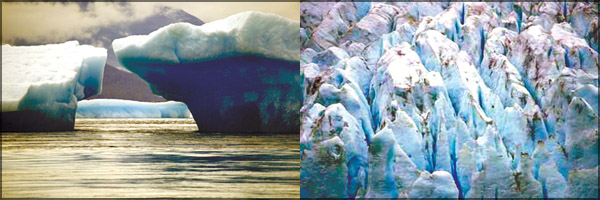 Glaciers - compact layers of snow Glaciers - compact layers of snow
Do you know what glaciers are? If you watch television, you must have
heard about this with regard to global warming. Even in the film Ice
Age, you would see these glaciers.
A glacier is a large, slow moving river of ice, which is formed from
compact layers of snow that slowly collapses and flows in response to
gravity. The process of glacier growth and establishment is called glaciation. The word glacier is formed from French via the Latin word
glacia, and ultimately from Latin glacies which means ice. flows in response to
gravity. The process of glacier growth and establishment is called glaciation. The word glacier is formed from French via the Latin word
glacia, and ultimately from Latin glacies which means ice.
Glacier ice is the largest reservoir of fresh water on Earth, and is
second only to oceans as the largest reservoir of total water. Glaciers
cover vast areas of the Polar regions, but are restricted to the highest
mountains in the tropics.
Many geologic processes are interrupted or modified significantly by
glaciers. Much rain becomes trapped in the glaciers instead of flowing
immediately back to the oceans, causing sea level drops and greatly
modifying the hydrology of streams. The Earth's crust is pushed down by
the weight of the ice, and melted water commonly collects and forms
lakes along the ice boundaries.
Glacial periods have come and gone repeatedly over the last million
years. Presently, the Earth is in a relatively warm period, called an
interglacial, worsened by global warming with the resulting retreat of
the glaciers. The Earth has been cyclically plunged into cold episodes,
however, called glacials, in which the extent of glaciers is expanded,
colloquially referred to as ice ages.
There are two main types of glaciers: alpine glaciers, which are
found in mountain areas, and continental glaciers, which can cover
larger areas. A temperate glacier is at melting point throughout the
year, from its surface to its base. The ice of polar glaciers is always
below freezing point with most mass loss due to sublimation (a process
in which a substance is converted directly from a solid to a gas or from
a gas to a solid without an intermediate liquid phase). Sub-polar
glaciers have a seasonal zone of melting near the surface and have some
internal drainage, but little to no basal melt.
Thermal classifications of surface conditions vary, so glacier zones
are often used to identify melt conditions. The dry snow zone is a
region where no melting occurs, even in the summer. The percolation
(filtering) zone is an area with some surface melt, and melting water
percolating into the snow pack.
 Often this zone is marked by refrozen ice lenses, glands, and layers.
The wet snow zone is the region where all of the snow deposited since
the end of the previous summer has been raised to zero centigrade, after
being below zero in the winter. The smallest alpine glaciers form in
mountain valleys and are referred to as valley glaciers. Often this zone is marked by refrozen ice lenses, glands, and layers.
The wet snow zone is the region where all of the snow deposited since
the end of the previous summer has been raised to zero centigrade, after
being below zero in the winter. The smallest alpine glaciers form in
mountain valleys and are referred to as valley glaciers.
Larger glaciers can cover an entire mountain, mountain chain or even
a volcano; this type is known as an ice cap. Ice caps feed outlet
glaciers, tongues of ice that extend into valleys below, far from the
margins of those larger ice masses. Outlet glaciers are formed by the
movement of ice from a polar ice cap, or an ice cap from mountainous
regions, to the sea.
The largest glaciers are continental ice sheets, enormous masses of
ice that are not visibly affected by the landscape and cover the entire
surface beneath them, except possibly on the margins where they are
thinnest. Antarctica and Greenland are the only places where continental
ice sheets currently exist. These regions contain vast quantities of
fresh water.
The volume of ice is so large that if the Greenland ice sheet melted,
it would cause sea levels to rise some six metres (20 feet) all around
the world. If the Antarctic ice sheet melted, sea levels would rise up
to 65 metres (210 feet). Plateau glaciers resemble ice sheets, but on a
smaller scale. They cover some plateaus and high-altitude areas.
This type of glacier appears in many places, especially in Iceland
and some of the large islands in the Arctic Ocean, and throughout the
northern Pacific Cordillera from southern British Columbia to western
Alaska.
Compiled by Janani Amarasekara
|
